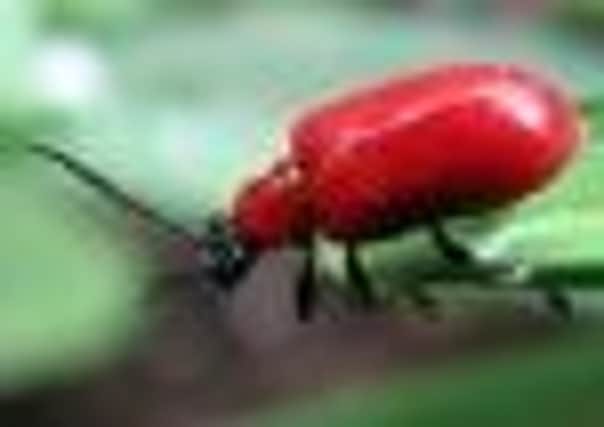All mouth and big appetite


An email enquiry and blurry pictures led to an interesting discovery about a new insect colonising Yorkshire.
The “caterpillars” looked like larvae of the infamous Colorado Beetle, short stubby, red and hunch-backed.
Advertisement
Hide AdAdvertisement
Hide AdHowever, this was no caterpillar, but a beetle larva. They look similar to Colorado Beetles, but this was in fact the Red or Scarlet Lily Beetle (Lilioceris lilii).
Adults are about 8 mm long, bright red with black head and legs.
The soft brown clumps from which ‘caterpillars’ appear to hatch, are actually the larvae gorging themselves on your prize lily plants – and covered with excrement – to appear like an unpleasant brown blob.
This sounds rather gross but is an adaptation to hide from predators.
Advertisement
Hide AdAdvertisement
Hide AdWhen the larvae are full grown, about 8-10 mm long, they descend the plants to pupate in nearby soil.
After two to three weeks, they emerge as adults and the cycle begins again.
Adult beetles first appear from over-wintering in soil in late March to May.
They may hibernate well away from lilies or other food plants.
Advertisement
Hide AdAdvertisement
Hide AdAfter feeding on suitable lily plants, they lay eggs, which hatch into tiny larvae after around a week, on the undersides of leaves.
You can find them in and amongst the lily leaves until around September.
The Royal Horticultural Society states that despite suggestions to the contrary, the beetle only has one generation per year.
The Lily Beetle is not a British native but arrived with exotic lilies.
Advertisement
Hide AdAdvertisement
Hide AdRecorded in the late 1800s, with several short-lived colonies, the earliest records of the beetle being long-term established were in 1939, from Chobham in Surrey.
The insect spread slowly through Surrey and into Berkshire in the 1950s, but was confined to south eastern England, until the late 1980s.
Then, presumably with climate change, it spread north.
By the 1990s it was turning up in Hampshire, Middlesex, Wiltshire, Dorset, Hertfordshire and Oxfordshire.
In 2002, it was in Glasgow and Belfast, and by 2009, in all English counties. In 2010, it was found in Wales.
Advertisement
Hide AdAdvertisement
Hide AdAdults and larvae cause damage to lilies and related species such as fritillaries.
Generally, they eat leaves and cause defoliation, but they also munch through flowers, seeds capsules and stems.
Interestingly, this little beast is native to Eurasia, though exactly where, nobody knows, and it is now invasive in North America too.
Professor Ian D Rotherham is a researcher, writer and broadcaster on wildlife and environmental issues.